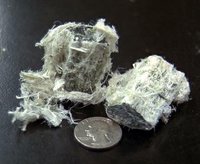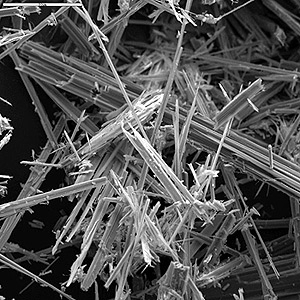Asbestos
Contents
Introduction
Asbestos is the name given to a number of naturally occurring fibrous silicate minerals that have been mined for their useful properties such as thermal insulation, chemical and thermal stability, and high tensile strength. The geology of asbestos (Asbestos) centers on the the three most common types: chrysotile, amosite, and crocidolite.
Chrysotile, also known as white asbestos and a member of the Serpentine mineral group is the commonest. Asbestos can only be identified under a microscope. Asbestos differs from other minerals in its crystal development. The crystal formation of asbestos is in the form of long thin fibers. Asbestos is divided into two mineral groups—Serpentine and Amphibole. The division between the two types of asbestos is based upon the crystalline structure. Serpentines have a sheet or layered structure where amphiboles have a chain-like structure. As the only member of the serpentine group, Chrysotile(A, B) is the most common type of asbestos found in buildings. Chrysotile makes up approximately 90%-95% of all asbestos contained in buildings in the United States.
In the amphibole group, there are five types of asbestos. As an acronym for the Asbestos Mines of South Africa, Amosite is the second-most prevalent type of asbestos found in building materials. Amosite is also known as "brown asbestos."
Next, there is Crocidolite or "blue asbestos," an asbestos found in specialized high temperature applications. The other three types (Anthophyllite, Tremolite, and Actinolite) are rare and found mainly as contaminants in other minerals. Asbestos deposits can be found throughout the world and are still mined in Australia, Canada, South Africa, and the former Soviet Union.
History
Early uses of asbestos exploited the reinforcement and thermal properties of asbestos fibers. The first recorded application can be traced to Finland (approximately 2500 B.C.), where anthophyllite from a local deposit was used to reinforce clay utensils and pottery. Numerous early references also can be found describing the use of asbestos fibers for the fabrication of lamp wicks and crematory clothing. Other applications of asbestos fibers in heat- or flame-resistant materials have been sporadically reported. At the end of the seventeenth century, Peter the Great of Russia initiated the fabrication of asbestos paper, using chrysotile fibers extracted from deposits in the Ural Mountains. The use of asbestos fibers on a true industrial scale began in Italy early in the nineteenth century with the development of asbestos textiles. By the end of the nineteenth century, significant asbestos deposits had been identified throughout the world and their exploitation had begun in Canada (1878), South Africa (1893, 1908-1916), and the USSR (1885).
From the beginning of the 20th century, the demand for asbestos fibers grew in a spectacular fashion for numerous applications, in particular for thermal insulation. The development of the Hatschek machine in 1900 for the continuous fabrication of sheets from an asbestos-cement composite also opened an important field of industrial application for asbestos fibers as did the development of the automobile industry for asbestos brakes, clutches, and gaskets.
World War II supported the growth of asbestos fiber production for military applications, typically in thermal insulation and fire protection. Such applications were later extended into residential or industrial constructions for several decades following the war.
During the late 1960s and 1970s, the finding of health problems associated with long-term heavy exposure to airborne asbestos fibers led to a large reduction in the use of asbestos fibers. In most of the current applications, asbestos fibers are contained within a matrix, typically cement or organic resins.
End uses for asbestos
Asbestos fibers have been used in a broad variety of industrial applications. In the peak period of asbestos consumption in industrialized countries, some 3000 applications, or types of products, have been listed. Because of recent restrictions and changes in end use-markets, most of these applications have been abandoned and the remainder is pursued under strictly regulated conditions.
The main properties of asbestos fibers that can be exploited in industrial applications are their thermal, electrical, and sound insulation; inflammability; matrix reinforcement (cement, plastic, and resins); adsorption capacity (filtration, liquid sterilization); wear and friction properties (friction materials); and chemical inertia (except in acids). These properties have led to several main classes of industrial products or applications.
Loose asbestos fibers, or formulations containing asbestos fibers for spray coatings, were widely used in the building industry for fire protection and heat or sound insulation during and following World War II. Such applications used mainly chrysotile or amosite, although crocidolite was commonly used in Europe, this practice was discontinued in the 1970s because of health concerns.
Asbestos fibers also have been widely used for the fabrication of papers and felts for flooring and roofing products, pipeline wrapping, electrical insulation, etc. Asbestos textiles, comprising yarn, thread, cloth, tape, or rope, also found wide application in thermal and electrical insulation and friction products in brake or clutch pads. In recent years, use of asbestos in these applications has decreased significantly. Production of asbestos roofing and flooring felts has been discontinued.
The reinforcing properties of asbestos fibers have been widely exploited in asbestos-cement products mostly by the construction and water industries. Asbestos-cement products such as board, pipe, and sheet represent by far the largest worldwide industrial consumption of asbestos fibers, an estimated 80% of the market in 1988. With market changes since 1988, asbestos-cement products now probably account for more than 98% of fiber sales.
Asbestos fibers also have been used to reinforce plastic products made from PVC, phenolics, polypropylene, nylon, etc. Reinforcement of thermoset and thermoplastic resins by asbestos fibers was used to develop products for the automotive, electronic, and printing industries. Except for some specialty products, the use of asbestos in plastics has essentially ceased.
The combination of asbestos fibers with various types of natural or synthetic resins has led to the development of a variety of products and applications. Among those, the incorporation of asbestos fibers (mainly chrysotile) into rubber matrices yields materials that were widely used for fabrication of packings and gaskets. Complex formulations, comprising short asbestos fibers (usually chrysotile), resins, and other fillers and modifiers, have been developed as friction materials for brake linings and pads. Asbestos fibers also have found broad application as reinforcing agents in coatings, sealants, and adhesive formulations. Of these applications, brake linings and pads, gaskets, and roof coatings comprise the bulk of the consumption.
Finally, the combined reinforcing effect and high absorption capacity of asbestos fibers were exploited in a variety of applications to increase dimensional stability, typically in vinyl or asphalt tiles and asphalt road surfacing. Asbestos is no longer being used in most western countries in manufacture of new products in these applications.
In recent years, most industrial applications involve asbestos fibers bonded within an organic or inorganic matrix. Asbestos-cement products account for the bulk of the world’s asbestos usage. In the United States, the major use is in roofing compounds (62%), followed by gaskets (22%), and friction products (11%). Small amounts of asbestos also are used to manufacture some insulation products and woven and plastic products.
Each type or group of products usually requires a selected asbestos fiber grade (or range of grades).
Exposure to asbestos
Asbestos exposure results from breathing in asbestos fibers. If rocks, soil, or products containing asbestos are disturbed, they can release asbestos fibers into the air. These fibers can be breathed into your lungs and could remain there for a lifetime. Asbestos exposure is not a problem if solid asbestos is left alone and not disturbed.
Almost everyone has been exposed to asbestos at some time in their life. Higher levels of asbestos are more common near: an asbestos mine; a factory or building being torn down or renovated that contains asbestos products; a waste site where asbestos is not properly covered up or stored to protect it from wind erosion; or an area containing naturally occurring asbestos that has been disturbed through activities that crush asbestos-containing rock or stir up dust in soils that contain asbestos fibers.
In indoor air, the concentration of asbestos depends on whether: asbestos was used for insulation, ceiling or floor tiles, or other purposes; whether these asbestos-containing materials are in good condition or are deteriorated and easily crumbled; activities in the house, such as repairs and home improvements have disturbed asbestos-containing materials; or asbestos has been brought into the home on shoes, clothes, hair, pet fur or other objects.
Outdoor air concentrations of asbestos can also contribute to indoor air asbestos levels.
Conditions under which asbestos is a hazard
Although exposure to asbestos clearly presents many different health hazards (Asbestos health hazards), asbestos is not always an immediate hazard. In fact, if asbestos can be maintained in good condition, it is recommended that it be left alone and periodic surveillance performed to monitor its condition. It is only when asbestos containing materials (ACM) are disturbed or the materials become damaged that it becomes a hazard. When the materials become damaged, the fibers separate and may then become airborne. In the asbestos industry, the term ‘friable’ is used to describe asbestos that can be reduced to dust by hand pressure. ‘Non-friable’ means asbestos that is too hard to be reduced to dust by hand. Non-friable materials, such as transite siding and floor tiles are not regulated provided it does not become friable. Machine grinding, sanding and dry-buffing are ways of causing non-friable materials to become friable.

| Disclaimer: This article contains information that was originally published by the Environmental Protection Agency, Agency for Toxic Substances and Disease Registry, and USGS. Topic editors and authors for the Encyclopedia of Earth have edited its content and added new information. The use of information from the Environmental Protection Agency, Agency for Toxic Substances and Disease Registry, and USGS should not be construed as support for or endorsement by that organization for any new information added by EoE personnel, or for any editing of the original content. |
